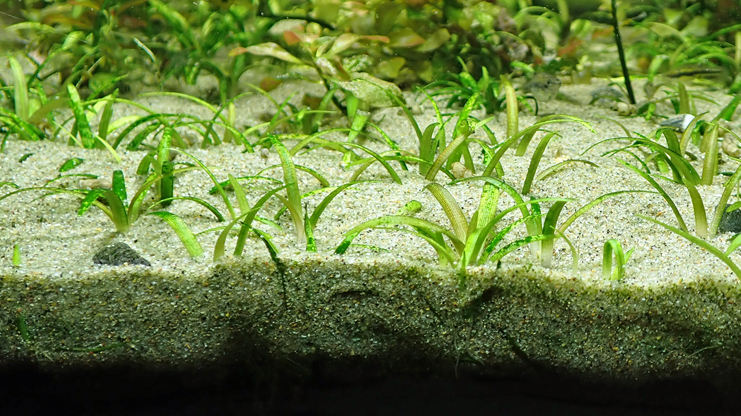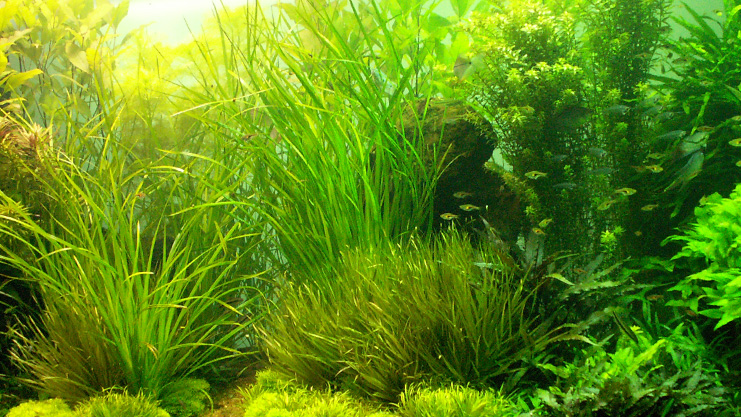Biological Processes In Substrate
Maximizing the Potential Benefits of the Bottom of the Aquarium

By Tony Griffitts
Published - 20241209, Revised:
The “From the Aquarium Lab” series of articles on substrate experiments increases the aquarium/pond hobbyists' understanding of the beneficial biological processes in the substrate. The grain size of the substrate used within the system affects many beneficial processes that can occur in the substrate. Many beneficial biological processes in the substrate will not happen if the hobbyist chooses the wrong substrate.
The best beneficial substrates have one common property, sand with fine grains (mesh/grit). Sands tested in the lab could develop anoxic (a lack of oxygen) environments at 1 cm or less depth. In most aquariums that are set up with sand, beneficial anaerobic bacteria will reduce nitrate (NO3).
Very small gravels (10 mesh/grit) can eventually develop an anoxic zone once detritus has filled in the gaps between the grains, reducing water flow through the substrate. It can take a year or more before the system can benefit from anaerobic biological processes. In the article From the Aquarium Lab - Oxidation Reduction Potential of Substrate - Evaluating ORP Values of Substrate Size, Depth, and the Effect of Current[1] the 10 mesh gravel tank was set up for 12 months with 5 cm (2 inches) of the substrate before ORP data was collected. The 10 mesh tank showed no anoxic environment at the bottom of the 5 cm substrate.
The beneficial biological processes that can occur in substrate go way beyond the aerobic ammonia-oxidizing bacteria and archaea (AOB/AOA) and nitrite-oxidizing bacteria and archaea (NOB/NOA) that need an “oxic” (a process or environment in which oxygen is involved or present) environment. Bacterial denitrification (part of the nitrogen cycle) can occur in a closed system if the hobbyist uses a substrate that promotes an anoxic environment.
Nitrate is not harmless (Isaza et al., 2020)[2]. Nitrate lowers the oxygen-carrying capacity of the fish's blood from an increased methemoglobin level. Methemoglobinemia (MetHb), also known as brown blood disease, prevents oxygen from reaching an animal's cells.
Nitrate reduction by anaerobic bacteria and archaea is a two-step process. Nitrate is first reduced to nitrite and then to nitrogen gas, which bubbles out of the substrate's anoxic zone. This two-step process can easily be observed when tuning a denitrification filter (denitrator)[3].
Hydrogen sulfide is produced in the substrate's anoxic zone. There is an aquarium myth about hydrogen sulfide building up in the substrate and killing fish. This simply cannot happen since it is a gas that will readily escape the water or be processed by bacteria in the oxic zone to sulfate, a nutrient for aquatic plants.
Hydrogen sulfide is processed into hydrogen sulfate in the oxic environment within the substrate. This aerobic process makes sulfate available as an aquatic plant micronutrient.
Biological phosphorus (phosphate) release occurs in anoxic conditions of the substrate. In areas of low oxygen, anaerobic microorganisms in the substrate break down organic matter. This anaerobic process will release phosphorus bound within organic compounds. Anaerobic bacteria release phosphorus as a byproduct of their metabolic processes. Phosphorus is the limiting nutrient for growth in a bacterium.[4]
Biological phosphorus removal (BPR) occurs in aerobic conditions. The bacteria in aerobic conditions convert organic substrates into energy and cell mass, which allows them to absorb phosphorus (phosphate).
Fermentation occurs in the anoxic environment below denitrification. It creates acetic acid that is consumed by the bacteria responsible for denitrification.
Methane is produced in the anoxic environment. This process creates molecules that can be processed into CO2.
Aerobic bacteria in the oxic zone oxidize methane to CO2, which aquatic plants can use as a nutrient.
Detritus decomposes in oxic and anoxic environments. Processing detritus creates many macro and micronutrients that aquatic plants can use.
Manganese reduction occurs in an anoxic environment. Manganese reduction creates a bioavailable micronutrient aquatic plants can use.
Iron reduction occurs in an anoxic environment. Iron reduction creates a bioavailable micronutrient aquatic plants can use.
Iron reduction occurs in an anoxic environment. Iron reduction creates a bioavailable micronutrient aquatic plants can use.
The substrate is responsible for diverse biological processes essential to maintaining healthy aquatic systems. Ensuring the substrate is deep enough to support anaerobic bacteria is vital to animal and plant health. The following is a list of biological processes that take place in the substrate at the bottom of the aquarium:
| Process | Bacteria Type | Importance |
|---|---|---|
| Ammonia oxidation | Aerobic | Detoxifies ammonia. |
| Nitrite oxidation | Aerobic | Detoxifies nitrite. |
| Denitrification | Anaerobic | Creates H2 gas, detoxifies nitrate. |
| Incomplete denitrification | Anaerobic | Creates nitrite. |
| Hydrogen sulfide production | Anaerobic | Creates H2S gas. |
| Hydrogen sufide oxidation to sulfate | Aerobic | Creates a micronutrient (sulfate). |
| Biological phosphorus release | Anaerobic | Creates a macronutrient (phosphate). A limiting nutrient for growth of bacteria and aquatic plants. |
| Biological phosphorus removal | Aerobic | Phosphate is removed by bacteria that live in oxic environments. Phosphate is also macronutrient for aquatic plants. |
| Fermentation | Anaerobic | Creates acetic acid, which can be used for denitrification. |
| Methane production | Anaerobic | Creates a gas that can be converted to CO2. |
| Methane oxidation | Aerobic | Creates a macronutrient (CO2). |
| Decomposition of detritus | Aerobic | Creates macro and micronutrients. |
| Decomposition of detritus | Anaerobic | Creates macro and micronutrients. |
| Manganese reduction | Anaerobic | Creates a bioavailable micronutrient (Mn). |
| Iron reduction | Anaerobic | Creates a bioavailable micronutrient (Fe). |
The diverse biological processes that take place in the substrate occur in specific environmental ranges that can be measured with an Oxidation-reduction potential (ORP) probe.
| Biochemical Activity | Approximate ORP range* |
|---|---|
| Nitrification | +150 to +500[5]* |
| Carbonaceous Biochemical Oxygen Demand (CBOD) | +50 to +250 |
| Biological phosphorus removal | +25 to +250 |
| Denitrification | -50 to +50 |
| Biological phosphorus release | -100 to -250 |
| Fermentation (acid formation) | -40 to -225 |
| Sulfide formation | -50 to -250 |
| Methane formation | -175 to -400 |
The dynamic variables of freshwater ecosystems play a significant role in anaerobic bacteria populations. A closed system must be physically and chemically favorable for developing an anoxic environment in the substrate for beneficial anaerobic bacteria to colonize.
The substrate size in an aquarium plays a significant role in the ecosystem's ability to benefit from anaerobic denitrification and biological nutrient production for aquatic plants. Using 1 cm or more of 30 mesh/grit or finer sand (the higher the mesh/grit number, the finer the sand) on the bottom of an aquarium provides the physical property for the anoxic environment to develop.
The “From the Aquarium Lab - Oxidation Reduction Potential of Substrate - Evaluating ORP Values of Substrate Size, Depth, and the Effect of Current”[1] shows the first centimeter of sand in a typical aquarium current is deep enough to develop an anoxic environment. A strong current above the sand will lower where the anoxic zone can be found. The experiment showed a consistent anoxic zone at 4 cm depth and an oxic (aerobic) zone at 1 cm depth. The 1 cm oxic zone quickly (14 hours) becomes strongly anoxic when returned to a typical aquarium current.
The water chemistry (carbonate hardness [KH] and general hardness [GH]) of a system will affect the species of bacteria and archaea that can thrive. A pH of 6 or below is a barrier for many species of freshwater bacteria responsible for the nitrogen cycle (including the anaerobic bacteria responsible for denitrification).
Anecdotal evidence of running a denitrator on a discus (Symphysodon spp.) display aquarium for months with a KH less than 1 dKH and a pH under 6.0 showed no ability to reduce nitrate. Further lab research will need to be done to validate this observation.
The temperature of the water will affect bacteria and archaea activity and the species that will thrive. Warmer temperatures will increase water exchange in the substrate from Brownian motion. Warmer water increases the speed of nitrification and denitrification.
Many hobbyists and fish breeders maintain systems with bare bottoms to facilitate the easy removal of detritus during water changes. One common issue with bare-bottom systems is that they tend to have high stocking densities, which produce a lot of nitrate.
If breeder systems had a minimum of 1 cm of sand on the bottom, anaerobic bacteria could provide some natural nitrate reduction (NNR). Nitrate inhibits growth and long-term fish health, so any NNR in the system will have benefits.
Ensure the aquarium (aquatic system) substrate is fine and deep enough to create a beneficial anoxic environment. The anoxic environment in the sand will aid in anaerobic denitrification. The production of many nutrients aquatic plants can use requires anoxic and oxic environments in the substrate. Anaerobic and aerobic bacteria and archaea work symbiotically to provide nutrients for beneficial bacteria and aquatic plants.
1. Tony Griffitts, From the Aquarium Lab - Oxidation Reduction Potential of Substrate - Evaluating ORP Values of Substrate Size, Depth, and the Effect of Current, AquaworldAquarium.com, 20240113,
http://www.aquaworldaquarium.com/articles/ORPofSubstrate.html
2. Daniel F Gomez Isaza, Rebecca L Cramp, Craig E Franklin, Simultaneous exposure to nitrate and low pH reduces the blood oxygen-carrying capacity and functional performance of a freshwater fish, Conservation Physiology, Volume 8, Issue 1, 2020, coz092,
https://doi.org/10.1093/conphys/coz092
3. Tony Griffitts, The Denitrator - What is a Denitrator? Why Do I Need One? How Does it Work?, AquaworldAquarium.com, 1991,
http://www.aquaworldaquarium.com/articles/Denitrator.html
4. Santos, M. M., Lemos, P. C., M Reis, M. A., & Santos, H. (1999). Glucose Metabolism and Kinetics of Phosphorus Removal by the Fermentative Bacterium Microlunatus phosphovorus. Applied and Environmental Microbiology, 65(9), 3920.
https://doi.org/10.1128/aem.65.9.3920-3928.1999
5. Government of Northwest Territories, Canada, Oxidation-Reduction Potential (ORP)
https://www.gov.nt.ca/ecc/sites/ecc/files/oxidation-reduction_potential.pdf



